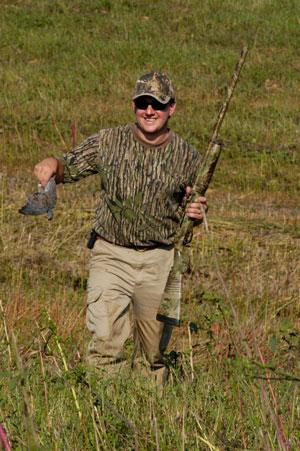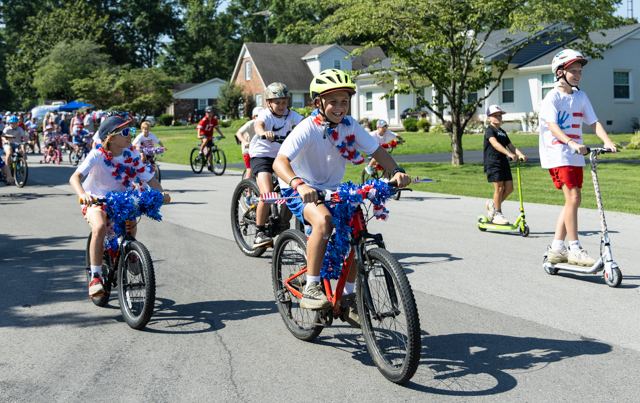Kentucky Afield Outdoors: Even with the hottest summer on record, dove season looks promising
Published 12:00 am Tuesday, September 7, 2010

- James Charas of Lexington holds a dove taken on opening day of dove season a few years ago. This year's dove season looks promising across most of Kentucky, but may be slightly down in west Kentucky from the heat and dry weather in that part of the state. Dove hunting presents a great opportunity to introduce a youth to the sport. Dove hunting involves a lot of shooting and activity to combat boredom and the short attention span of young people. Dove season opens Sept. 1 statewide.
The foggy, dewy mornings presage the coming of fall. Crispness lingers in the pre-dawn air, making a tee shirt, shorts and flip-flops slightly uncomfortable when you first step outside.
For many, these developments bring slight gloom as summer is over, but for hunters, fog and cool air mean dove season opens soon. Fall is our favorite time of year.
This year’s dove season looks good from the perspective of mid-August. “There seems to be a lot of doves about,” said Rocky Pritchert, migratory bird program coordinator for the Kentucky Department of Fish and Wildlife Resources. “I’m hearing the fields that are ready hold good numbers of birds. However, a cold snap could push birds south.”
Dove season opens Sept. 1 and closes Oct. 24. The season opens again Nov. 25 and closes Dec. 3. A third segment of dove season runs from Jan. 1 through Jan. 7, 2011. The daily bag limit is 15 doves.
Dove concentrations seem best in the central, southern and eastern sections of Kentucky. “All our fields look really good,” said Dave Frederick, Bluegrass Region public lands biologist for Kentucky Fish and Wildlife. “The Bluegrass Region looks promising. I am seeing quite a few birds.”
The western end of Kentucky felt the effects of late spring flooding, followed by scorching heat and little rainfall.
“In west Kentucky, they’ve had dry conditions since June. This came right after the late spring flooding,” Pritchert said. “The low rainfall combined with the high temperatures brought extremely dry fields and dried out crops. Dove fields in that part of the state may be a little spotty. We are not in as good a shape in west Kentucky as in past years.”
Pritchert explained another factor will be at play this dove season. “We are two to three weeks early this year for crops,” he said. “We are seeing corn harvested right now. Silage fields will be cut early. This could spread birds out as these food sources compete with dove fields sown in sunflowers or millet. Finding a concentration of doves could be a little tougher this year.”
Also, the cut corn and silage fields may cause doves to abandon dove plots sown in sunflowers, millet or wheat after the first few days of the season. “You may not get as many shoots from a field as normal,” Pritchert said. “Once shot, they may move off that field quickly because there are so many more feeding opportunities.”
Dove hunting provides lots of shooting and lots of action, perfect for taking a son, daughter, niece, nephew or grandchild hunting for the first time. Kids love dove hunting because they get to shoot often. Make sure youth comply with hunter education and licensing requirements before going afield.
Choose your spot in the dove field wisely. Where you set up to hunt doves often dictates your success for that day. Any veteran dove hunter has witnessed someone who was in the hot part of a field. They shoot three, four or five times for every shot you take and leave the field in an hour with their limit of birds. The group next to them bolts from their former area to claim the hot spot.
“I like to find perch spots such as dead trees, power lines, somewhere they can come in and perch,” said John Brunjes, migratory bird biologist for Kentucky Fish and Wildlife. “Dove use perches to feel comfortable. They survey the scene and make sure it is safe. Then, they fly down into the field and feed. If you hunt near that perch, you’ll often be the first to limit out.”
Scout the field you plan to hunt prior to opening day. Check for perch spots and observe where doves enter the field. Look for gravel driveways, fencerows or lines of trees doves use in flight as sight lines to lead them to watering areas, resting areas and places to feed.
Bare dirt is also a big draw for doves. If you can find a spot in the field with bare dirt and a dead tree or power line nearby, then you may have stumbled onto the hot spot of that field. Doves also use gaps in lines of trees to enter fields. Hunters who set up on either side of that gap should enjoy some good pass shooting.
Doves are incredibly green on opening day. Many doves fly close by and slowly. This lends the impression to some that they may wear anything to the dove field. Leave the yellow tee shirts, khaki shorts and white tennis shoes at home. Wear a camouflage shirt, preferably long sleeve, and a wide-brimmed camo hat at the least. Many veteran dove hunters don head-to-toe camouflage, even on opening day.
A wide-brimmed camo hat helps shield your face until the dove is in range. Don’t move to swing your shotgun until the last possible moment to prevent birds from flaring away from you. Patience pays bigger dividends as dove season wears on and birds grow wary.
For more details on dove hunting, the 2010-2011 Kentucky Dove Hunting Guide is available wherever licenses are sold and on the Internet at fw.ky.gov. All dove hunters should keep a copy of this guide on their person while dove hunting.
The guide lists public dove fields all over the state that hunters may use on selected days for first segment of dove season. Treat these fields as you would your own. Carry out your trash and retrieve your spent shotshell hulls. Don’t clean doves at the dove field. Drive only on the road leading to and from the dove field.
“These are the biggest reasons we lose public dove fields,” Pritchert explained. “The lack of respect shown by some hunters to the landowner really hurts the cooperative dove field program.”
Dove hunting should be good this fall in Kentucky. Scout the dove field, set up in a good spot, dress properly and respect the landowner. Dove breasts wrapped in bacon and slowly grilled make all the preparation worth it.
Author Lee McClellan is an award-winning associate editor for Kentucky Afield magazine, the official publication of the Kentucky Department of Fish and Wildlife Resources. He is a life-long hunter and angler, with a passion for smallmouth bass fishing.
The Kentucky Department of Fish and Wildlife Resources manages, regulates, enforces and promotes responsible use of all fish and wildlife species, their habitats, public wildlife areas and waterways for the benefit of those resources and for public enjoyment. Kentucky Fish and Wildlife is an agency of the Tourism, Arts and Heritage Cabinet. For more information on the department, visit our web site at fw.ky.gov.






